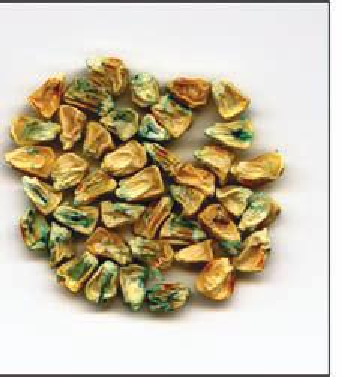Agriculture Reference
In-Depth Information
TESTS for dETECTInG dAMAGE of THE SEEd CoAT
There are a number of tests that can be used to evaluate seed viability and quality and help provide a more
comprehensive understanding of germination potential. These include the tetrazolium test and various vigor
tests considered in Chapters 7 and 8. Other tests that help reveal the physical integrity of the seed coat
include the fast green test, indoxyl acetate test, ferric chloride test, and sodium hypochlorite test.
fast Green Test
The fast green test reveals physical fractures in the seed coat of light colored seeds and is often used in
corn. Seeds are soaked in a 0.1% solution of fast green for 10 minutes. During this period, the vital stain
penetrates into areas of the seed that have lost their physical integrity and stains them green. After soaking,
the seeds are washed and any deformations are clearly identii ed by green markings (Fig. 5.12).
Figure 5.12. Indoxyl acetate test of soybean on left and fast green test of sweet corn on right. It is used to
detect physical damage to the seed coat.
Indoxyl Acetate Test
The indoxyl acetate test was developed to detect seed coat cracks in legume seeds (French et al., 1962).
Later work by Paulsen and Nave (1979) adapted the test for detecting seed coat damage in soybean. This
test is very quick. Seeds are soaked in a solution of 0.1% indoxyl acetate for 10 seconds and then sprayed
with a 20% ammonia solution for 10 seconds. If the seed coat is not injured, no reaction occurs. But where
the seed coat is cracked, the indoxyl acetate solution soaks into the seed tissue and causes staining (Figure
5.12). Enzymatically, esterase enzymes hydrolyze the indoxyl acetate and produce an indigo pigment in
the presence of oxygen (Hoffman and McDonald, 1981). A green stain is produced in the seed coat cracks
making damaged areas quickly and clearly visible.
ferric Chloride Test
Mechanically injured areas of legume seeds turn black when placed in a solution of ferric chloride (Oregon
State University, 1986). A solution of 20% ferric chloride (FeCl
3
) is prepared by adding four parts water to
one part FeCl
3
. Two 100-seed replicates in dishes or saucers are completely immersed in the FeCl
3
solution.
After 5 minutes, the black staining seeds exhibiting mechanical damage are separated from those remain-


